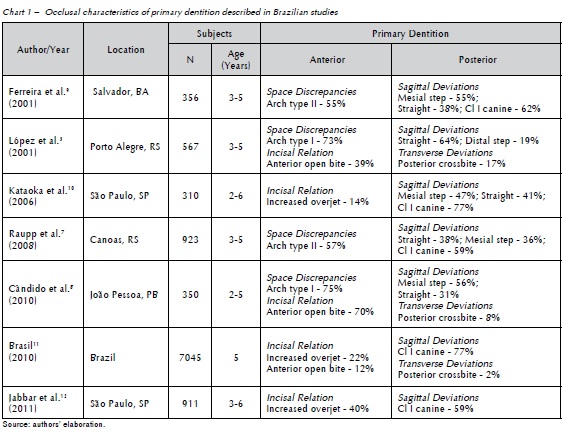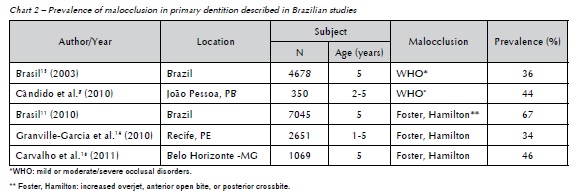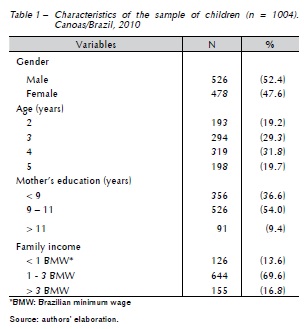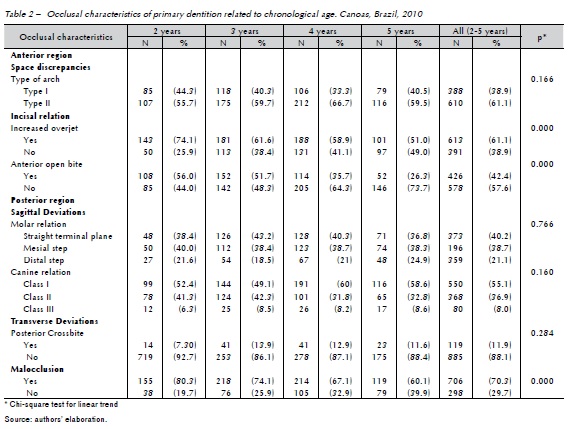Serviços Personalizados
Artigo
Links relacionados
Compartilhar
RFO UPF
versão impressa ISSN 1413-4012
RFO UPF vol.21 no.2 Passo Fundo Mai./Ago. 2016
Assessment of occlusal characteristics of the primary dentition: a cross-sectional study in Brazilian preschool children
Avaliação das características oclusais da dentição decídua: um estudo transversal em pré-escolares brasileiros
Juliane Bervian I; Carlos Alberto Feldens II; Paulo Floriani Kramer III; Larissa Correa Brusco Pavinato IV
I Departament of Pediatric Dentistry, Faculty of Dentistry, Universidade de Passo Fundo, Passo Fundo, RS, Brazil
II Departament of Pediatric Dentistry, Faculty of Dentistry, Universidade Luterana do Brasil, Canoas, RS, Brazil
III Departament of Pediatric Dentistry, Faculty of Dentistry, Universidade Luterana do Brasil, Canoas, RS, Brazil
IV Departament of Pediatric Dentistry, Faculty of Dentistry, Universidade de Passo Fundo, Passo Fundo, RS, Brazil
Abstract
Objective: The present study aimed to determine the occlusal characteristics and prevalence of malocclusion among Brazilian preschool children. Subjects and method: A cross-sectional study was conducted with 1004 children aged 2-5 years enrolled in public preschools of the city of Canoas, RS, Brazil. A questionnaire was administered to guardians addressing demographic, socioeconomic, and behavioral characteristics of the children and their families. The clinical exam was performed by previously calibrated dentists and the characteristics of the primary dentition were verified according to set criteria. Data analysis was performed through the chi-square test. Results: Stability in the sagittal and transverse planes of the posterior region, and a variability of incisal relations in the primary dentition were verified. The findings show high prevalence of malocclusion (70.3%) and its association with age. Conclusion: Considering the high prevalence of malocclusion in primary dentition, implementing educational programs and prevention measures for preschool children is highlighted.
Keywords: Dental occlusion. Epidemiology. Malocclusion. Prevalence. Tooth deciduous.
Resumo
Objetivo: este trabalho teve como objetivo determinar as características oclusais e a prevalência de oclusopatias em pré-escolares brasileiros. Sujeitos e método: foi realizado um estudo transversal em 1.004 crianças, de 2 a 5 anos de idade, matriculadas nas escolas de educação infantil do município de Canoas, RS. Um questionário foi aplicado aos responsáveis com questões demográficas, socioeconômicas e comportamentais sobre as crianças e suas famílias. O exame clínico foi realizado por dentistas previamente calibrados e as características da dentição decídua foram verificadas de acordo com critérios estabelecidos. A análise dos dados foi realizada por meio do teste Qui-Quadrado. Resultados: verificou-se uma estabilidade no plano sagital e transversal na região posterior e uma variabilidade nas relações incisais na dentição decídua. Os achados demonstraram uma alta prevalência de oclusopatias (70,3%) e constatou-se associação com a idade. Conclusão: devido à alta prevalência de oclusopatias na dentição decídua, destaca-se a importância da implementação de programas educativos e preventivos em pré-escolares.
Palavras-chave: Oclusão dentária. Epidemiologia. Má oclusão. Prevalência. Dente decíduo.
Introduction
The development of occlusion depends on the harmonic growth of the maxilla and mandible, and the role of the functional matrix, which correlates form and function1. In the primary dentition, however, occlusal relation has been underexplored2.
The characteristics of the anterior region in primary dentition are classified by space discrepancies (type of arch) and incisal relation (overjet and anterior open bite) and the posterior region is identified by sagittal deviations (molar and canine relation) and transverse deviations (posterior crossbite). Studies performed in the last 60 years report the most common features that may predict the favorable development of the permanent dentition3, including the presence of diastemas in the anterior region, non-increased overjet and overbite, straight or mesial step of primary molars, and Class I canine relation4-8. Chart 1 shows some of the occlusal characteristics of the primary dentition described in Brazilian studies published since the year 2000.

It is generally agreed that the occlusion of primary dentition plays a role in determining the occlusion in corresponding permanent dentition2,3. A great number of studies report the prevalence of malocclusion in different populations, with rates ranging from 34% to 67%11,13,14. The criteria employed for determining malocclusion is likely the most important factor explaining these differences. Chart 2 displays the results of Brazilian studies published since the year 2000. Although occlusal features of the primary dentition have been described in the literature from the investigations performed by Baume in the 1950s, few population-based studies have performed separate analyses of anterior and posterior regions. The present study aimed to determine occlusal characteristics and prevalence of malocclusion of public preschool children aged two to five years in the city of Canoas, southern Brazil.

Subjects and method
Subjects and study design: a cross-sectional study was conducted involving preschool children in the city of Canoas (Southern Brazil), which has a population of approximately 324,000 inhabitants and all households have access to fluoridated public water supply (fluoride level: 0.8 ppm). An oral health census was performed from June to December 2010. The study population included all 1380 children aged two to five years enrolled at public preschools and their parents/guardians. Exclusion criteria were the presence of one or more erupted permanent teeth, ongoing or previous orthodontic treatment, and the absence of any primary teeth.
Data collection: six teams consisting of an examiner (dentist, MSc student) and an auxiliary (undergraduate student) performed the fieldwork. Data were collected at preschools by means of a clinical oral examination of children and structured interviews with guardians.
Demographic and socioeconomic questionnaire: A questionnaire was administered to guardians addressing children's gender (male/female), age (2, 3, 4, and 5 years), mother's level of education (categorized as <9 years, 9 to 11 years, and >11 years), and family income (categorized as <1 BMW, 1 to 3 BMW, and >3 BMW). The Brazilian minimum wage was approximately US$ 300 at the time of data collection.
Clinical examination: Children were examined in a preschool classroom, lying on ordinary desks under natural light. Teeth were cleaned and dried with gauze. The clinical examination was exclusively visual and performed with the aid of a dental mirror, tongue depressor, and a millimeter ruler. Biosafety measures established by the WHO were strictly followed17.
The characteristics assessed in the anterior region were space availability (type of arch) and incisal relation (overjet and anterior open bite), and those evaluated in the posterior region were sagittal deviations (molar and canine relation) and transverse deviations (posterior crossbite). The occlusal characteristics of primary dentition were described using the following standard and previously published definitions6,18:
- Type of arch: measured as contact between teeth and categorized as lack of contact between adjacent teeth (type 1) or imbrications (overlapping of adjacent teeth; type II).
- Incisal overjet: measured as the distance between the palatal surface of the most protruded maxillary incisor and the labial surface of the corresponding mandibular incisor, and categorized as normal (≤2 mm) or increased (>2 mm).
- Anterior open bite: based on the vertical relation between upper and lower central incisors, defined as the absence of vertical overlap of lower incisors, and categorized based on presence/absence.
- Terminal plane of primary molars: class I or straight - distal surface of upper and lower second primary molars on the same vertical plane in centric occlusion; class II or distal step
- distal aspect of the lower second primary molar in posterior relation to that of the upper second primary molar in centric occlusion; and class III or mesial step - distal face of lower second primary molar in anterior relation to that of the upper second primary molar in centric occlusion.
- Canine relation: class I - tip of the upper primary canine on the same vertical plane as the distal aspect of the lower primary canine in centric occlusion; classes II and III - tips of upper primary canines in anterior and posterior relation to the distal aspect of lower primary canine in centric occlusion, respectively.
- Posterior crossbite: upper primary molars occluded in lingual relation to lower primary molars and categorized as presence/absence. - Malocclusion: recorded when the child presented at least one of the following characteristics - increased overjet, anterior open bite, or posterior crossbite.
Intra-examiner and inter-examiner reliability were measured using kappa statistics. Interexaminer reliability ranged from 0.84 (95% CI: 0.64-1.00) to 1.00, and intra-examiner reliability ranged from 0.79 (95% CI: 0.60-0.98) to 1.00.
Data analysis: statistical analysis was performed using the Statistical Package for Social Sciences (version 16.0, SPSS Inc., Chicago, IL, USA). The chi-square test was used to investigate whether there were differences in occlusal characteristics and malocclusion in different age groups.
Ethical considerations: this study was approved by the human research ethics committee of Universidade Luterana do Brasil (ULBRA). The participants' rights were protected. The guardians read and signed an informed consent form prior to participation. Children with dental problems were referred to the School of Dentistry of ULBRA, where treatment was ensured.
Results
Participation rate was 90.2% (1245/1380). Losses occurred due to repeated absences of the child on the day of the examination (n = 69), failure to bring the informed consent form signed by the parents (n = 28), impossibility of contacting guardians for the interview (n = 21), and child's refusal during clinical examination (n = 17). Moreover, data on 241 participants were excluded from the final analysis because of the presence of erupted permanent teeth (n = 197), ongoing orthodontic treatment (n = 12), and absence of primary teeth (n = 32). Thus, the final sample comprised 1004 children.
Table 1 presents sample characteristics. Mean age was 3.5 years (SD = 1.0), and maternal level of education varied from 0 to 16 years; 54.1% of mothers had between 9 and 11 years of education. Household income was low, with 83.2% of families earning less than three times the monthly Brazilian minimum wage (approximately US$ 900).

Table 2 shows the occlusal characteristics of the sample. A total of 61.1% of children had imbrications in the anterior region. No significant association was found between age and the frequency of spacing and crowding in the anterior region (p = 0.166). Regarding incisal relation, most children (61.1%) had increased overjet (>2 mm), and anterior open bite was found in 426 children (42.4%). Age was associated with both conditions, and there was a significant reduction in the prevalence of increased overjet; also, anterior open bite occurred with the increase in age (p < 0.01). For molar relation, a straight terminal plane was found in 40.2% of children, whereas distal and mesial steps were found in 21.1% and 38.7%, respectively. For canine relation, 550 children (55.1%) had Class I relation, 368 (36.9%) had Class II relation, and 80 (8%) had Class III relation. No significant associations were found between age and molar (p = 0.766) or canine (p = 0.160) relation. Regarding transverse deviations, posterior crossbite was found in 11.9% of children and was not significantly associated with age (p = 0.284). The prevalence of malocclusion in primary dentition was 70.3%. A total of 706 children showed anterior open bite, increased overjet, or posterior crossbite. Furthermore, malocclusion varied through the different dental development periods (p < 0.01), and there was a significant reduction in prevalence with the increase in age.

Discussion
The frequently used term "normal occlusion" may hardly be applied to the wide variety of conditions that seem to exist in primary dentition. Moreover, some authors believe that primary dentition remains unchanged in preschool children4. Thus, studies are required to address these assumptions, and new data are required for a full understanding of this biogenetic course2,19.
The main findings of the present study highlight four important issues concerning the development of primary dentition: (1) stability of arches on sagittal and transverse planes in the posterior region, (2) variability in incisal relation; (3) high prevalence of malocclusion, and (4) the association between malocclusion and age. Moreover, this investigation has particular characteristics that should be noted. The study design was appropriate for the identification of individuals with and without malocclusion. The sample size of 1004 participants provides the study with the precision that has often been lacking in many previously conducted studies in this field, which leads to greater potential of meeting the proposed objectives.
Occlusal relation and their significance to the development of primary and permanent dentition may be assessed by focusing on different features, depending on the dental arch region involved - anterior or posterior. In the present study, the posterior region was characterized by the stability of dental arches on sagittal and transverse planes between the ages of two and five years. The literature available also suggests that these characteristics persist into the mixed dentition phase20-22. The anteroposterior relation herein observed indicates a prevalence (80%) of straight terminal relation or mesial step for molars, and Class I canine relation was found in more than 50% of the sample. Such features contribute to the favorable development of mixed and permanent dentitions2,3,7,9-12.
Posterior crossbite is characterized by a transverse interarch discrepancy in response to a reduction in transverse dimension of the maxillary arch20. In the present study, transverse deviations were found in 11.9% of children. The incidence of constriction of the maxillary arch in primary dentition has an etiological relation to frequent sucking habits (either thumb or dummy sucking) in this development stage, associated or not with respiratory problems. Crossbite requires immediate treatment because it is not self-correcting and creates skeletal changes that make later correction difficult22,23.
The anterior region should be analyzed separately based on space availability and incisal relation. The findings of the present study indicate a prevalence of type II arch in nearly 2/3 of children. The absence of spacing in maxillary labial segment constitutes a risk factor for dental caries in preschool children24,25 and is unfavorable to the proper alignment of permanent dentition26.
Incisal relation may show significant changes in primary dentition. Increased overjet (>2 mm) and anterior open bite were found in 61.1% and 42.4% of the children examined, respectively. Increased overjet has been identified as a risk factor for traumatic dental injury, and anterior open bite is considered the malocclusion with the highest esthetic and functional impact in childhood27-29. Moreover, sucking habits have been indicated as an etiological factor for increased overjet and anterior open bite30-34.
The literature reports a tendency toward the spontaneous correction of abnormalities in incisal relation of primary dentition4,8. In the present study, the distribution of increased overjet was 74.1% in two-year-olds and 51% in five-year-olds (linear decrease with age). Open bite from sucking habits usually self-corrects after removing the habit. However, there is cause for concern, as a more severe degree of malocclusion established in the early stages of occlusal development may not self-correct with normal growth and development20.
In contrast, the present findings show that the stability of occlusal relation in primary dentition may only be associated with the sagittal and transverse planes in the posterior region. In the anterior region, there is a tendency toward self-correction of the abnormal incisal relation, especially anterior open bite. Nonetheless, the prevalence of malocclusion at five years of age is high (70.3%). A recent Brazilian national epidemiological survey reports similar findings to those of the present study, with prevalence rate of 66.7% using the same index11.
A balanced occlusion in primary dentition favors the proper development of chewing, speech, and breathing functions in a critical period of both physical and emotional growth and development32. Psychological conditions related to esthetic problems and the prevention of upper incisor fractures from trauma may influence the decision in favor of an earlier intervention27.
Thus, as breastfeeding and non-nutritive sucking habits are associated and showed opposite effects on the prediction of malocclusions12,21,31, implementing educational programs and prevention measures in early childhood is essential to reduce the prevalence of malocclusion among preschoolers. Considering that the positive influence of breastfeeding may be masked by the effect of exposure to persistent non-nutritive sucking habits, it is suggested that further studies are planned with a longitudinal design, including a larger sample size.
Conclusions
The findings of the present study indicate stability in the posterior region and considerable variability in the incisal relation of primary dentition. Moreover, the prevalence of malocclusion was high, with higher prevalence rate among younger children. Thus, despite the methodological limitations, this study represents a valid contribution to promoting educational programs and prevention measures in early childhood to reduce or even eliminate etiological factors related to malocclusion.
References
1. Randall LE, Beck FM, Huja SS. Bone remodeling surrounding primary teeth in skeletally immature dogs. Angle Orthod 2011; 81(6):931-7. [ Links ]
2. Góis EG, Vale MP, Paiva SM, Abreu MH, Serra-Negra JM, Pordeus IA. Incidence of malocclusion between primary and mixed dentitions among Brazilian children. A 5-year longitudinal study. Angle Orthod 2012; 82(3):495-500.
3. Peres KG, Peres MA, Thomson WM, Broadbent J, Hallal PC, Menezes AB. Deciduous-dentition malocclusion predicts orthodontic treatment needs later: findings from a population-based birth cohort study. Am J Orthod Dentofacial Orthop 2015; 147(4):492-8.
4. Baume LJ. Physiological tooth migration and its significance for the development of occlusion. I. The biogenetic course of the deciduous dentition. J Dent Res 1950; 29(2):123-32.
5. López FU, Cezar GM, Ghisleni GC, Farina JC, Beltrame KP, Ferreira ES. Prevalência de maloclusão na dentição decídua. Rev Fac Odontol 2001; 43(2):8-11.
6. Grabowski R, Stahl F, Gaebel M, Kundt G. Relationship between occlusal findings and orofacial myofunctional status in primary and mixed dentition. Part I: Prevalence of malocclusions. J Orofac Orthop 2007; 68(1):26-37.
7. Raupp SMM, Ruschel HC, Ferreira SH, Kramer PF. Contribuição ao estudo das características morfofuncionais da dentição decíduas: análise em pré-escolares da cidade de Canoas/RS. Pesq Bras Odontoped Clin Integr 2008; 8(2):197-202.
8. Cândido IRF, Figueiredo ACP, Cysne SS, Santiago BM, Valença AMG. Características da oclusão decídua em crianças de 2 a 5 anos de idade em João Pessoa, PB, Brasil. Pesq Bras Odontoped Clin Integr 2010; 10(1):15-22.
9. Ferreira RI, Barreira AK, Soares CD, Alves AC. Prevalência de características da oclusão normal na dentição decídua. Pesq Odontol Bras 2001; 15(1):23-8.
10. Kataoka DY, Scavone HJr., Vellini-Ferreira F, Cotrim- Ferreira FA. Estudo do relacionamento ântero-posterior entre os arcos dentários decíduos, de crianças nipobrasileiras, dos dois aos seis anos de idade. Rev Dental Press Ortodon Ortop Facial 2006; 11(5):83-92.
11. Brasil. Ministério da Saúde. Secretaria de Assistência a Saúde. Projeto SB Brasil 2010. Condições de saúde bucal da população brasileira – Resultados principais. Brasília: Ministério da Saúde; 2010.
12. Jabbar NS, Bueno AB, Silva PE, Scavone-Junior H, Ferreira RI. Bottle feeding, increased overjet and Class 2 primary canine relationship: is there any association? Braz Oral Res 2011; 25(4):331-7.
13. Sousa RV, Pinto-Monteiro AK, Martins CC, Granville-Garcia AF, Paiva SM. Malocclusion and socioeconomic indicators in primary dentition. Braz Oral Res 2014; 28(suppl):54-60.
14. Granville-Garcia AF, Ferreira JM, Menezes VA. Prevalence of anterior open bite and overjet preschoolers in the city of Recife (PE, Brazil). Cien Saude Colet 2010; 15(Suppl 2):3265-70.
15. Brasil. Ministério da Saúde. Secretaria de Assistência a Saúde. Projeto SB Brasil 2003. Condições de saúde bucal da população brasileira – Resultados principais. Brasília: Ministério da Saúde; 2004.
16. Carvalho AC, Paiva SM, Scarpelli AC, Viegas CM, Ferreira FM, Pordeus IA. Prevalence of malocclusion in primary dentition in a population-based sample of Brazilian preschool children. Eur J Paediatr Dent 2011; 12(2):107-11.
17. World Health Organization. Oral health surveys: basic methods. 4. ed. Geneva: World Health Organization; 1997.
18. Foster TD, Hamilton MC. Occlusion in the primary dentition. Br Dent J 1969; 126(21):76-9.
19. Hermont AP, Martins CC, Zina LG, Auad SM, Paiva SM, Pordeus IA. Breastfeeding, bottle feeding practices and malocclusion in the primary dentition: a systematic review of cohort studies. Int J Environ Res Public Health 2015; 12(3):3133-5.
20. Silva Filho OG, Santamaria Jr. M, Capelozza Filho L. Epidemiology of posterior crossbite in the primary dentition. J Clin Pediatr Dent 2007; 32(1):73-8.
21. Macena MCB, Katz CRT, Rosenblatt A. Prevalence of a posterior crossbite and sucking habits in Brazilian children aged 18-59 months. European J Orthodontics 2009; 31(4):357-61.
22. Agarwal SS, Nehra K, Sharma M, Jayan B, Poonia A, Bhattal H. Association between breastfeeding duration, non-nutritive sucking habits and dental arch dimensions in deciduous dentition: a cross-sectional study. Prog Orthod 2014; 31(15):59.
23. Heimer MV, Tornisiello Katz CR, Rosenblatt A. Nonnutritive sucking habits, dental malocclusions, and facial morphology in Brazilian children: a longitudinal study. Eur J Orthod 2008; 30(6):580-5.
24. Stahl F, Grabowski. Malocclusion and caries prevalence: is there a connection in the primary and mixed dentitions? Clin Oral Investig 2004; 8(2):86-90.
 Endereço para correspondência:
Endereço para correspondência:
Juliane Bervian
Faculdade de Odontologia
Universidade de Passo Fundo
BR 285, São José
99052-900 Passo Fundo, RS - Brasil
e-mail: jbervian@upf.br
Recebido: 14/07/2016
Aceito: 18/08/2016













